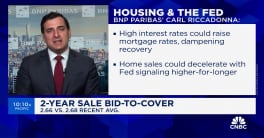In a speech Friday on financial reform, Federal Reserve Governor Daniel K. Tarullo, spoke about issues involved in implementing both Basel II and the Dodd-Frank Act, reforming minimum capital requirements and addressed the issue of bank dividends.
Though long viewed as a supervisory tool, Tarullo said, U.S. bank regulators did not impose explicit minimum capital requirements until the 1980s when Congress saw the capital ratios of the largest banks declining while they faced enormous foreign loan losses. The U.S. response ultimately led to the original Basel Accord.
Regulators came to regard capital requirements as a supple tool which as regulations eased, appeared to be a promising way to protect the public interest with a buffer against bank losses where financial institutions had access to the Federal Reserve's discount window and Federal Deposit Insurance. The idea also evolved that maintaining a material equity value for the bank would disincentivize excessive risk-taking. In the quarter century that followed, capital requirements largely became the dominant prudential regulatory tool.
The recent crisis showed that this regulatory focus had caused the world to ignore other risks; the implications of the growth in size, leverage, and maturity transformation levels of the shadow banking system for the balance sheets of commercial banks and for overall financial stability. The limitations of capital requirements as a regulatory tool, such as the frequent lag between declines in asset values and reductions in bank capital, were also confirmed by experience during the crisis. But it was also evident that capital requirements were not high enough or set with respect to particular assets and that some of the instruments that qualified as "Tier 1 capital" were not reliable buffers against losses.
Tarullo said at the height of the crisis counterparties and other market actors relied almost exclusively on the amount of tangible common equity as a measure of the creditworthiness and overall stability of those financial institutions, essentially ignoring the Tier 1 and total risk-based capital ratios. The resulting widespread doubt about the stability some institutions made investors and counterparties reluctant to deal with them, thus contributing to severe liquidity strains.
Going forward, the regulatory system will not be as dependent on capital requirements and Dodd-Frank itself is testimony to this fact. There will be increased emphasis on market discipline, liquidity regulation, activities restrictions, and more effective supervision. But robust capital requirements should continue to be a central component of the financial regulatory system. The U.S. banking agencies, and most of our counterparts from countries represented in the Basel Committee on Banking Supervision, made strengthening the capital regime a high priority in the latest financial reform agenda.
Basel III makes a number of important changes to address deficiencies in the pre-crisis capital rules:
- It creates new minimum common equity capital requirements and provides a definition for the calculation of common equity that will prevent the inclusion of certain assets that could dilute its loss-absorbing character.
- The minimum common equity ratio will be set at 4.5% of risk-weighted assets, with an additional requirement for a 2.5% "conservation buffer." The minimum ratio defines the amount of common equity needed for a firm to be regarded as a viable financial intermediary; the conservation buffer, a new feature of capital regulation, is intended to reflect the losses that a firm may suffer during periods of financial stress.
The practical effect of the two-level approach is that banks under stress may let their common equity ratio drop below the 7% level that is the sum of the minimum and buffer requirements. However, restrictions on capital distributions will result, which will become progressively more stringent as the common equity ratio drops closer to the 4.5% minimum. The buffer is thus designed to forestall banks from continuing to pay dividends even as they come under stress
- Basel III changes the risk weights assigned to a financial institution's traded assets and counterparty exposures. The changes in risk weights incorporate some elements of a macroprudential perspective as, for example, in higher capital requirements on equity investments in other financial firms and credit exposures to large financial firms
- It provides for a minimum leverage ratio, roughly similar to requirements already applicable under national law in the US and Canada.
- The US favored a significant transition period for Basel III but not the eight years now required. Most US banking entities expect to meet the new requirements considerably sooner, but the phase is between 2013 and 2019 was an important inducement for some countries to agree to the new, much stronger standards.
Tarullo noted that a number of market analysts have said there is considerable apparent variation in the risk-weightings applied by different banks so the fed is urging the Basel Committee to explore mechanisms for ensuring that these strengthened capital standards lead to a consistency in application, as well as in the provisions of relevant domestic regulations.
The GHOS agreed in September that systemically important institutions should have loss absorbing capacity beyond the Basel III requirements. As this parallels a Dodd-Frank requirement, the Federal Reserve thinks it best to develop our plans for domestic statutory obligation in tandem with our participation in this international process.
As the financial system has stabilized, Tarullo said some firms have indicated an interest in resuming or increasing dividends, or repurchasing shares. Until Basel III was completed and Dodd-Frank enacted, it was obviously difficult for any firm to provide a forward looking demonstration that its capital position would be protected even under stressed conditions. While there continues to be a relatively high degree of uncertainty, the basic questions surrounding capital and regulatory reform have now been answered and the Federal Reserve will soon be issuing supervisory guidelines applicable to dividend requests from the largest holding companies. The Fed's approach will be a conservative one requiring firms to submit convincing capital plans that demonstrate their ability to absorb losses over the next two years under an adverse economic scenario it will specify, and still remain amply capitalized. Firms will have a sound estimate of any significant risks that may not be captured by the stress testing, such as potential mortgage putback exposures, and the capacity to absorb any consequent losses. The firms will also be asked to show how, even with their proposed capital distributions, they will readily and comfortably meet the Basel III requirements as they come into effect, as well as to accommodate any business model changes that might be necessitated by Dodd-Frank.
In implementing the Dodd-Frank Act, Tarullo said the Board of Governors will employ a transparent process that goes well beyond the usual notice and comment requirements. The Federal Reserve is entering into the public record a summary of all communications with non-government groups and organizations and has joined with other regulatory agencies in sponsoring joint forums to solicit views from industry, academics, consumer groups, and others.
Tarullo also addressed what he called the "mortgage foreclosure documentation imbroglio, the latest chapter in the recent sad history of mortgage finance in this country" and took aim at what he called a perverse set of incentives for homeowners with underwater mortgages. Homeowners who try to get mortgage modifications are too frequently subject to delay and disappointment while those who simply stop paying their mortgages find they can often stay in their homes for a year or more rent free. This is not a good outcome from any perspective, he said. Regardless of the causes of this situation, "it just cannot be the case that foreclosure is preferable to modification - including reductions of principal" where the costs are so high. Tarullo said he hoped that the servicers and investors will take this occasion not just to correct the documentation flaws or to argue over who should bear the financial losses, but to invigorate the modification process.







